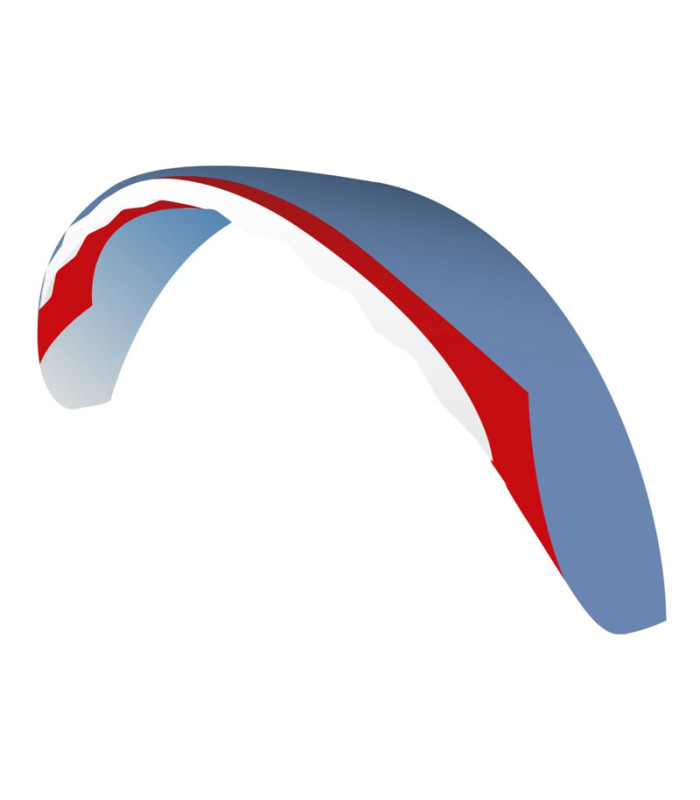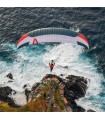Where nature meets engineering
The Boomerang 12 's performance has been significantly improved compared to its predecessor. Used by the Gin team riders, it is already a podium winner, with a victory in Turkey in 2021.
Certification: CCC
Sizes: S / SM / M / ML / L
Surface area (m² ) : 21.50 / 22.41 / 23.33 / 24.3 / 25.92
Weight (Kg ) : 5.7 / 5.9 / 6 / 6.1 / 6.3
Takeoff Weight (Kg ): 80-95 / 95-105 / 100-112 / 105-117 / 110-127
Aspect ratio: 7.55
Boomerang 12: The competition wing
The advantages of the Boomerang 12 over the 11:
- Improved rate-of-climb performance thanks to increased lift and delayed stall.
- Better transition performance thanks to improved aerodynamic efficiency
- Improved handling thanks to reduced aspect ratio and cell count
- Better overall stability, especially in turbulence and at high speeds
- Significant progress in extreme flight maneuvers, especially frontal and asymmetric collapses. In CCC tests, the S size passed EN-D high-speed flight tests.
WAVE LEADING EDGE technology
The Boomerang 12 innovates with the "Wave Leading Edge". Inspired by the tubercles of the humpback whale, this technology has been applied to paragliders thanks to theGIN LAB*, a wind tunnel project run by Gin Gliders in collaboration with the Ulsan National Institute of Science and Technology in South Korea.
A word from the designer about the Boomerang 12
Designer Gin Seok Song explains the Boomerang 12 development process:
"The GIN Lab was created to discover the next revolutionary technology in paragliding. We knew that we were approaching the limits of what was possible by simply modifying parameters such as aspect ratio or cell count, so we were motivated to seek a radical evolution.
After consulting Professor Jooha Kim of the Ulsan National Institute of Science and Technology, we were intrigued by his research into the tubercles on the leading edge of the humpback whale's flipper.
Professor Jooha Kim: Over millions of years, living creatures have evolved highly efficient mechanisms for coping with the challenges of their environments. The tubercles on the pectoral fin of the humpback whale are a case in point. They have been shown to improve performance and lift at high angles of attack. This gives the whale incredible agility despite its imposing size.
After Gin explained some of the performance challenges of paragliders, I was very interested to see how this concept could be applied to them. Tuberized airfoils always stall progressively, and can be used at higher pitch angles to increase lift. Drag is significantly reduced and wingtip stall can be mitigated, if not completely eliminated.
These performance characteristics mean that profiles with tubercles are hyper-stable and high-performing.
We decided that the wind tunnel would be an invaluable tool, enabling us to carry out hundreds of experiments and rapid iterations on small modifications.
Gin Seok Song: The first challenge was to calibrate the wind tunnel's initial results with our computer simulations and with our experience of the wing's actual behavior. Once we had a proven model, we were able to try out different leading edge configurations.
We then selected the most promising results and built real paragliders. It was immediately clear that this concept had potential, especially in terms of wing stability and climb rate.
A year and a half later, the project had progressed, enabling us to certify the Boomerang 12 with this new leading edge technology: we decided to call it the "Wave Leading Edge" because it was inspired by marine life and had a sinusoidal appearance.
What was surprising was the ease of certification: after one closure, the shooting is very reduced and the wingtips don't snake like with the previous generation of 2 lines.
The wing was flown for the first time by our factory pilots at the PWC 2021 Superfinal in Disentis, Switzerland, with encouraging results and podiums in the individual and team rankings, followed by victory at the PWC Turkey and, in 2022, the top 3 places at the PWC Brazil.
We're very excited about the future of the Wave Leading Edge, the stability and high angle-of-attack performance should benefit the majority of wing categories."
TECHNICAL DETAILS
- Wave Leading Edge technology increases lift at all angles of attack and reduces drag at low angles
- 3rd generation EPT (Equalized Pressure Technology) profile technology
- 2 risers / 2 lines
- Mini-ribs on trailing edge
- Comfortable B-control handles
- MATERIALS
- Fabrics
- Top surface leading edge: Dominico 30D MF (WR) 41g/m² / 27g/m² main top surface: Porcher Sport Skytex 32g/m² / 27g/m²
- Porcher Sport Skytex 32g/m² / 27g/m²
- Main bottom: Porcher Sport Skytex 27g/m² / 27g/m²
- Lines
- Top: Edelrid 8001 090 | 070 | 050 | 025
- Intermediates: Edelrid 8001 130 | 090 | 070 | 050 | 025
- Low: Edelrid 8001 360 | 190 | 090 | 070











